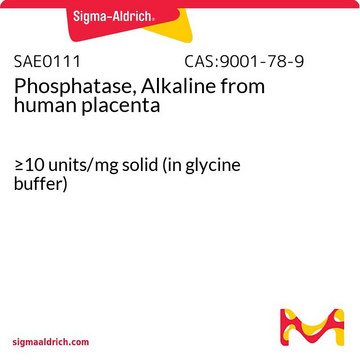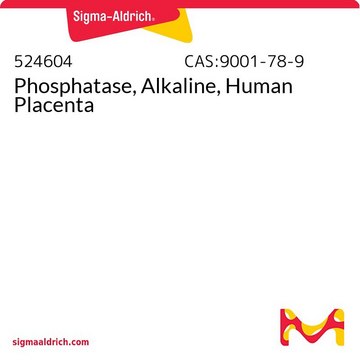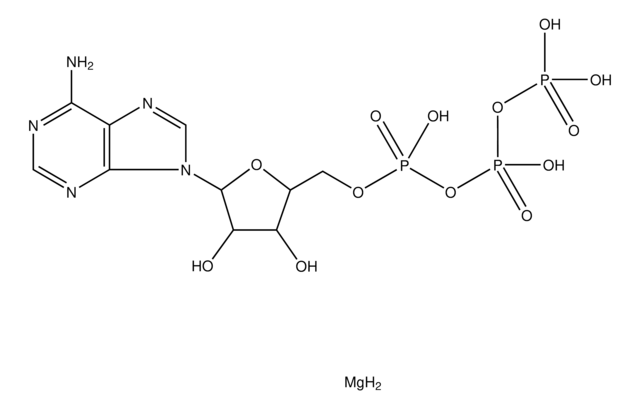P3895
Phosphatase, Alkaline from human placenta
≥10 units/mg solid (in glycine buffer)
Synonym(s):
Orthophosphoric-monoester phosphohydrolase (alkaline optimum)
Sign Into View Organizational & Contract Pricing
All Photos(1)
About This Item
Recommended Products
form
solid
Quality Level
specific activity
≥10 units/mg solid (in glycine buffer)
UniProt accession no.
storage temp.
−20°C
Gene Information
human ... ALPP(250)
Looking for similar products? Visit Product Comparison Guide
Application
Alkaline phosphatase is used for conjugation to antibodies and other proteins for ELISA, Western blotting, and histochemical detection. It is routinely used to dephosphorylate proteins and nucleic acids. It may be used for protein labeling when high sensitivity is required. Alkaline phosphatase may be also be used to dephosphorylate the 5′-termini of DNA or RNA to prevent self-ligation. DNA or RNA can also be tagged with radiolabeled phosphate (via T4 polynucleotide kinase) after dephosphorylation with alkaline phosphatase.
Biochem/physiol Actions
Alkaline phosphatase dephosphorylates proteins and nucleic acids. Human placental alkaline phosphatase (PLAP) has an unique residue, Glu-429. It is an allosteric enzyme that is uncompetitively inhibited by L-Phe, L-Trp, and L-Leu. PLAP is post-translationally modified. Phosphatidylinositol-specific phospholipase C may be involved in the release of PLAP. PLAP may have a role in cell division and may be involved in the transfer of maternal IgG to the fetus.
Unit Definition
One unit will hydrolyze 1 μmole of 4-nitrophenyl phosphate per minute at pH 10.4 at 37 °C.
inhibitor
Product No.
Description
Pricing
Signal Word
Danger
Hazard Statements
Precautionary Statements
Hazard Classifications
Resp. Sens. 1
Storage Class Code
10 - Combustible liquids
WGK
WGK 1
Flash Point(F)
Not applicable
Flash Point(C)
Not applicable
Regulatory Information
常规特殊物品
Choose from one of the most recent versions:
Already Own This Product?
Find documentation for the products that you have recently purchased in the Document Library.
Mary F O'Leary et al.
Nutrients, 13(12) (2021-12-29)
Shatavari has long been used as an Ayurvedic herb for women's health, but empirical evidence for its effectiveness has been lacking. Shatavari contains phytoestrogenic compounds that bind to the estradiol receptor. Postmenopausal estradiol deficiency contributes to sarcopenia and osteoporosis. In
Yongliang Yang et al.
Chemical biology & drug design, 78(6), 923-931 (2011-09-14)
Human placental alkaline phosphatase has been identified as a hydrolase that is significantly overexpressed on the surface of various solid tumor cells, and is therefore a suitable prodrug design target for non-invasive cancer imaging and therapy. Structure-based prediction of enzymatic
M H Le Du et al.
The Journal of biological chemistry, 276(12), 9158-9165 (2001-01-01)
Human placental alkaline phosphatase (PLAP) is one of three tissue-specific human APs extensively studied because of its ectopic expression in tumors. The crystal structure, determined at 1.8-A resolution, reveals that during evolution, only the overall features of the enzyme have
M D McKee et al.
Journal of dental research, 92(8), 721-727 (2013-05-23)
Phosphatases are involved in bone and tooth mineralization, but their mechanisms of action are not completely understood. Tissue-nonspecific alkaline phosphatase (TNAP, ALPL) regulates inhibitory extracellular pyrophosphate through its pyrophosphatase activity to control mineral propagation in the matrix; mice without TNAP
Timothy M Chlon et al.
Journal of virology, 88(19), 11315-11326 (2014-07-18)
DNA repair plays a crucial role in embryonic and somatic stem cell biology and cell reprogramming. The Fanconi anemia (FA) pathway, which promotes error-free repair of DNA double-strand breaks, is required for somatic cell reprogramming to induced pluripotent stem cells
Our team of scientists has experience in all areas of research including Life Science, Material Science, Chemical Synthesis, Chromatography, Analytical and many others.
Contact Technical Service






